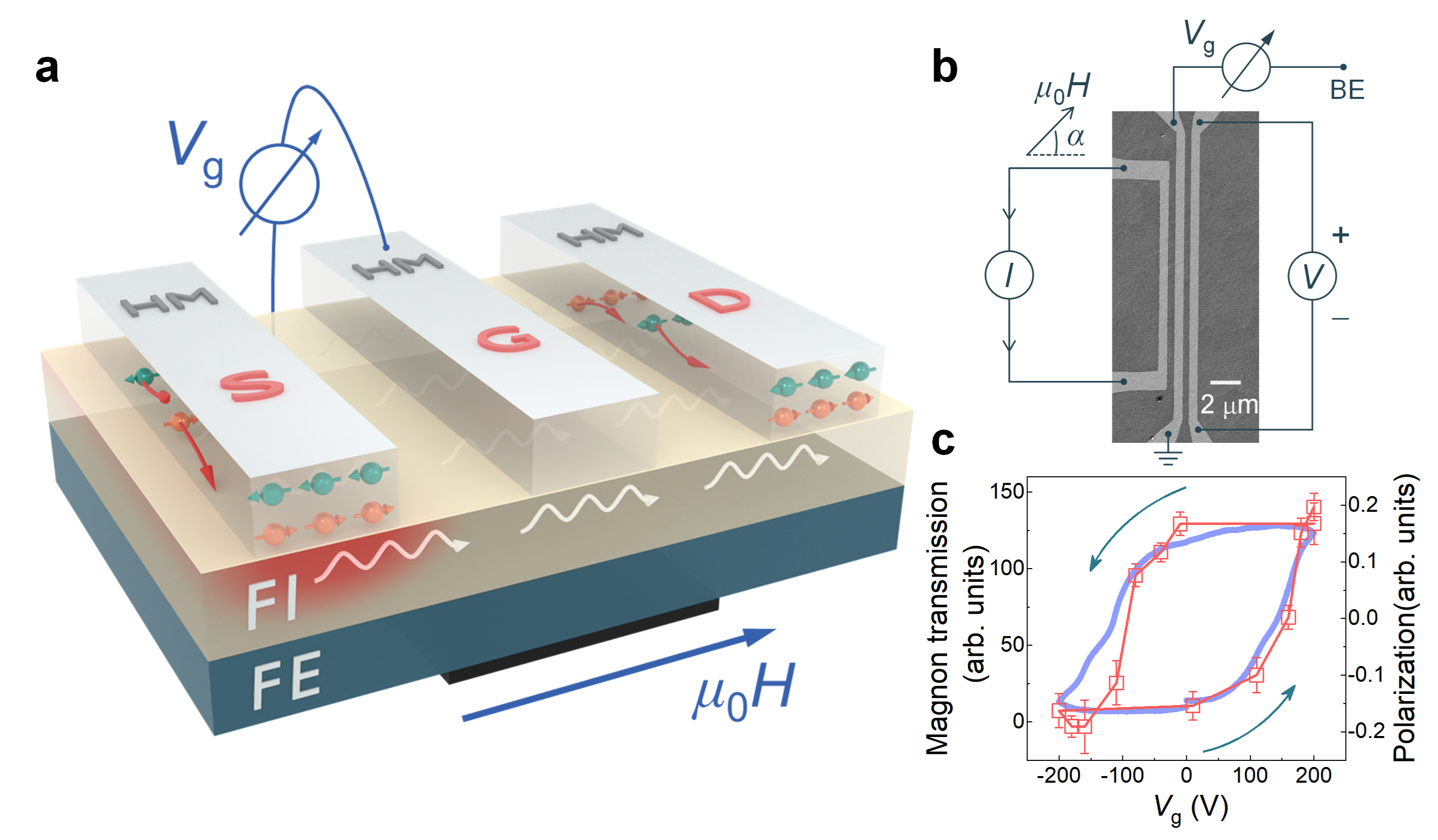Magnon Field Effect Transistor: Paving the Way for Energy-Efficient Computing in the Post-Moore Era

Since the 1960s, the density of transistors in integrated circuits has followed Moore's Law, doubling approximately every two years. These remarkable advancements in modern electronics, however, also encounter a critical challenge — power consumption. As transistors shrink and operate at higher speeds, the heat they generate increases substantially, making thermal management increasingly difficult. This growing heat issue poses a significant barrier to the continued progress of semiconductor technology, highlighting the urgent need for alternative solutions.
One promising alternative is the use of magnons. Magnons are the collective excitations of magnetic moments capable of transmitting spin information without electron motion. This unique property eliminates the major source of energy consumption in traditional electronic circuits, i.e., the Joule heating. In addition, magnons can switch magnetic moments, and thus control the binary information encoded in the direction of those magnetic moments (up or down), making them an attractive candidate for information transmission and storage in the post-Moore era. With these advantages, magnons show strong potential as highly efficient information carriers and control knobs for future computing technologies and logic devices.
Given the pivotal role of field-effect transistors (FETs) in modern electronics, there is significant interest in developing a magnonic equivalent. However, unlike the charge currents in semiconductors, which are easily controlled by electric fields, regulating magnon currents with electric fields presents a greater challenge. This difficulty stems from the fact that magnons are electrically neutral, and the interaction between the electric field and magnetic moments is generally weak due to different symmetry requirements. Although some theoretical and experimental studies have shown that electric fields can induce frequency shifts in spin waves, a practical method for controlling magnon flow via electric fields has yet to be achieved.
Significant efforts have been devoted to develop various designs for magnon transistors, with several prototypes already introduced. These devices either transmit magnon currents vertically or use gating mechanisms based on electric currents or magnetic fields. However, to enable fully functional magnonic circuits, a magnon transistor must adopt a lateral structure with three terminals — similar to conventional FETs — to allow efficient cascading in circuits. Furthermore, such a transistor should be scalable, energy-efficient, preferably controlled by an electric field, and exhibit non-volatility. While progress has been made in controlling magnon currents through magnon-magnon scattering and magnetization switching, realizing a three-terminal magnon FET with electric field control remains an outstanding challenge.

Fig. 1 | a Sketch of a three-terminal magnon field-effect transistor (Magnon FET). Three heavy-metallic (HM) stripes are placed onto a ferromagnetic or ferrimagnetic insulator (FI) /ferroelectric (FE) bilayer. The left stripe acts as the magnon source (S), and the transmission of magnons to the right detector (D) stripe can be modulated by the voltage pulses Vg applied at the middle gate (G) stripe, which is located in the middle. Additionally, a bottom electrode is positioned beneath the FE layer and is aligned with the G-stripe. The magnetic field μ0H is applied in the film plane. b SEM image of a typical three-terminal magnon FET device. c Magnon transmission (red) as a function of the gate voltage pulse Vg, exhibiting a typical hysteresis similar to the polarization loop (blue) obtained on the same sample.
Our work achieved a breakthrough by designing and experimentally demonstrating a room-temperature, non-volatile, three-terminal lateral magnon FET. Our device consists of a ferrimagnetic insulator (Y3Fe5O12) layered on a ferroelectric material [Pb(Mg1/3Nb2/3)0.7Ti0.3O3 or Pb(Zr0.52Ti0.48)O3], with three platinum stripes patterned on the magnetic layer serving as the injector, gate, and detector, respectively. By applying electric field pulses at the gate, we successfully achieved strong modulation of the thermally excited magnon currents propagating laterally from the source to the detector at room temperature with an on/off ratio as high as 400%. We propose that the modulation arises from an electric polarization-dependent magnon current relaxation in the magnet, driven by magnetoelectric coupling at the interface of ferrimagnet and ferroelectric layers.
Our finding establishes a fully functional nonvolatile magnon FET at room temperature. It opens the door for the design of novel, energy-efficient magnonic logic circuits. This work marks a significant step toward developing magnon-based electronics. Further, it underscores the potential of magnon transistors as candidates for low-power computing solutions, especially in applications such as conventional logic computing and emerging neuromorphic computing.
Over the years, our group, led by Professor Haifeng Ding, has focused on the exploration of low-dimensional magnetism and spintronics. Recently, our group proposed and experimentally realized the artificial magnetic skyrmion crystals (Phys. Rev. Lett., 110, 167201, 2013); developed a self-consistent method in determining the spin Hall angle of heavy metals (Sci. Adv., 4, eaat1670, 2018); demonstrated the inverse Rashba-Edelstein effect at the interfaces between Ag-Bi and ferromagnetic metals (Phys. Rev. Lett., 129, 097203, 2022); built logic devices at the atomic level (Nat. Common., 11, 1400, 2020); demonstrated the anomalous spin Hall effect in ferromagnetic metals and achieved the field-free switching in perpendicularly magnetized YIG films (Nat. Common., 15, 3201, 2024), presented a method to separate the spin Hall effect and spin splitting effect in an altermagnet (Phys. Rev. Lett., 133, 046701, 2024), etc. For more details, please visit our webpage: https://ldm.nju.edu.cn.
This work titled “A nonvolatile magnon field effect transistor at room temperature” was published in the latest volume of Nature Communications journal (https://doi.org/10.1038/s41467-024-53524-7).
Follow the Topic
-
Nature Communications

An open access, multidisciplinary journal dedicated to publishing high-quality research in all areas of the biological, health, physical, chemical and Earth sciences.
Related Collections
With Collections, you can get published faster and increase your visibility.
Women's Health
Publishing Model: Hybrid
Deadline: Ongoing
Advances in neurodegenerative diseases
Publishing Model: Hybrid
Deadline: Dec 24, 2025






Please sign in or register for FREE
If you are a registered user on Research Communities by Springer Nature, please sign in